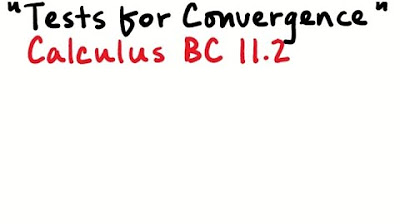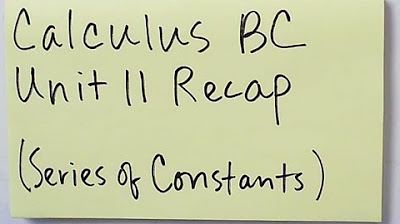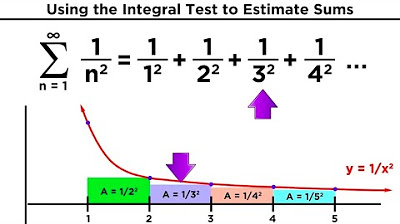Calculus BC – 10.6 Comparison Tests for Convergence
TLDRIn this calculus lesson, Mr. Bean introduces comparison tests for determining the convergence or divergence of series. He explains two types of tests: the direct comparison test, which requires identifying a smaller series to an already known convergent or divergent series, and the limit comparison test, which simplifies the process by comparing series without needing to establish which is larger. Through various examples, Mr. Bean demonstrates how to apply these tests, emphasizing the importance of recognizing series types like geometric and p-series for accurate convergence assessments.
Takeaways
- 📚 The lesson is about comparison tests for convergence in calculus, taught by Mr. Bean.
- 🔍 There are two types of comparison tests discussed: the standard comparison test and the limit comparison test.
- 📉 If a series a_n is smaller than another series b_n for all n, and b_n converges, then a_n also converges.
- 📈 The concept is easier to understand with graphical representation, where a smaller series under a converging larger series also converges.
- 🔻 Conversely, if a series a_n is diverging and another series b_n is above it, b_n must also diverge.
- 🔢 The comparison test requires identifying which series is larger or smaller before making conclusions about convergence or divergence.
- 🌟 The limit comparison test is an alternative method that does not require knowing which series is larger; it involves taking the limit of the ratio of the two series as n approaches infinity.
- 💡 If the limit of the ratio is finite and positive, both series either converge or diverge together.
- ✂️ The process often involves 'reducing' the series to their most significant terms for easier comparison, focusing on the behavior as n approaches infinity.
- 📝 Examples are given to illustrate how to apply these tests, including comparing series to known convergent or divergent series like geometric or p-series.
- 📚 Understanding these tests helps in determining the convergence or divergence of complex series by comparing them to simpler, more familiar series.
Q & A
What are the two types of comparison tests for convergence discussed in the script?
-The script discusses the Comparison Test and the Limit Comparison Test as the two types of tests for determining the convergence or divergence of a series.
According to the Comparison Test, what happens if a series 'a_n' is smaller than another series 'b_n' for all 'n'?
-If 'a_n' is smaller than 'b_n' for all 'n' and if 'b_n' converges, then 'a_n' also converges. However, if 'a_n' is diverging, it does not necessarily imply that 'b_n' is diverging.
Can you explain the concept of 'quotation marks reduce' or 'horizontal asymptotes' in the context of the Limit Comparison Test?
-The 'quotation marks reduce' or 'horizontal asymptotes' concept refers to focusing on the largest terms of a series when comparing it to another, ignoring the coefficients and smaller terms, to determine the behavior as 'n' approaches infinity.
What is the condition for two series to have the same convergence behavior in the Limit Comparison Test?
-In the Limit Comparison Test, if the limit of the ratio of the two series as 'n' approaches infinity exists, is finite, and is positive, then both series either converge or diverge together.
How does the script illustrate the Comparison Test using a graphical representation?
-The script uses a graphical representation where if 'a_n' is below a converging 'b_n', it implies that 'a_n' also converges. Conversely, if 'a_n' is above a diverging 'b_n', then 'a_n' must also diverge.
What is the significance of knowing whether a series is larger or smaller when using the Comparison Test?
-Knowing whether 'a_n' is larger or smaller than 'b_n' is crucial because it determines the convergence behavior. If the larger series converges, the smaller one must also converge, and if the smaller series diverges, the larger one must also diverge.
Can the Comparison Test be used if the series being compared is diverging?
-No, if the series 'b_n' that 'a_n' is being compared to is diverging, the Comparison Test cannot be used to make any conclusions about the convergence of 'a_n'.
What is the main advantage of the Limit Comparison Test over the Comparison Test according to the script?
-The main advantage of the Limit Comparison Test is that it does not require you to know which series is larger or smaller; it only requires both series to be positive and the limit of their ratio to be finite and positive for determining convergence or divergence.
How does the script use the concept of 'reduced comparison' in the context of the Limit Comparison Test?
-The script uses 'reduced comparison' by focusing on the leading terms of the series when comparing them in the Limit Comparison Test, ignoring coefficients and smaller terms to simplify the comparison.
What is the nth term test mentioned in the script, and how does it relate to the convergence of a series?
-The nth term test is a test where you take the limit of the nth term of a series as 'n' approaches infinity. If the limit does not equal zero, the series is guaranteed to diverge. If it equals zero, it does not guarantee convergence but is inconclusive for determining convergence.
Outlines
📚 Introduction to Comparison Tests for Convergence
In this educational video, Mr. Bean introduces the concept of comparison tests used in calculus to determine the convergence or divergence of complex series. He explains two types of comparison tests, emphasizing the need to compare a given series to a simpler, known series such as geometric or p-series. The video begins with a fundamental principle: if a series 'a(n)' is smaller than 'b(n)' for all 'n', and 'b(n)' converges, then 'a(n)' must also converge. Mr. Bean illustrates this with a graphical representation, showing how a smaller series 'a(n)' that lies beneath a converging 'b(n)' must also converge. He also covers the reverse scenario where if 'a(n)' diverges, the larger series 'b(n)' must also diverge. The explanation is designed to help students visualize and understand the comparison tests before applying them to examples.
📘 Applying Comparison Tests with Examples
Mr. Bean proceeds to apply the comparison tests to specific examples, demonstrating how to determine which series is larger or smaller by comparing the denominators of fractions. He uses the geometric series '1/2^n' as a reference, showing that if '1/(3+2^n)' is less than '1/2^n', the latter's convergence implies the convergence of the former. However, when dealing with a series involving subtraction, like '1/4^n - 3', he points out that knowing one series converges does not necessarily inform us about the convergence of the other. He suggests finding another series to compare for a conclusive result. The video emphasizes the importance of careful comparison and understanding the relationship between the series being analyzed.
🔍 Exploring the Limit Comparison Test
Transitioning to the limit comparison test, Mr. Bean explains a method that simplifies the process by eliminating the need to identify which series is larger. Instead, the test involves taking the limit of the ratio of the terms of the series as 'n' approaches infinity. If the limit is a positive finite number, both series converge or diverge together. He illustrates this with examples, showing how to 'reduce' a series to its most significant terms for comparison and how to calculate the limit to determine convergence. The video highlights the ease of use of the limit comparison test, especially when dealing with more complex series where it's not straightforward to determine which series is larger.
📘 Further Examples of Limit Comparison Test
Continuing with the limit comparison test, Mr. Bean provides additional examples to solidify the concept. He shows how to simplify series to their most significant terms for comparison and how to calculate the limit to determine if the series converges or diverges. The examples include series with terms like '1/√(3n)' and '1/n^(3/2)', where the comparison with p-series helps in understanding the convergence behavior. Mr. Bean also touches upon the nth term test, which is used to determine divergence when the limit of the term does not equal zero. The video concludes with a summary of the key differences between the comparison test and the limit comparison test, highlighting the advantages of the latter in certain scenarios.
🎓 Conclusion and Sign Off
In the final part of the video, Mr. Bean wraps up the lesson by summarizing the key points covered in the tutorial. He emphasizes the importance of understanding the comparison test and the limit comparison test, as well as the significance of knowing other series tests such as the geometric series, p-series, and the nth term test. He encourages students to practice these tests to become proficient in analyzing the convergence of various series. Mr. Bean signs off, reminding students to review the material and look forward to the next lesson.
Mindmap
Keywords
💡Comparison Test
💡Convergence
💡Divergence
💡Geometric Series
💡P-Series
💡Limit Comparison Test
💡Horizontal Asymptote
💡nth Term Test
💡Coefficients
💡Leading Terms
Highlights
Introduction to comparison tests for determining the convergence or divergence of a series.
Explanation of two types of comparison tests: direct comparison and limit comparison.
Direct comparison test principle: If a_n ≤ b_n for all n and b_n converges, then a_n also converges.
Illustration of the direct comparison test using graphical representation.
Limit comparison test principle: If the limit of a_n/b_n as n approaches infinity is a positive finite number, both series converge or diverge together.
Demonstration of the direct comparison test with an example comparing 1/(3+2^n) to 1/2^n.
Use of the limit comparison test to determine the convergence of a series involving n^2 - 2.
Comparison of a series with a p-series, where p > 1, to establish convergence.
Application of the limit comparison test to a series with terms involving square roots and cubic powers of n.
Explanation of how to reduce a series to its leading terms for comparison in the limit comparison test.
Demonstration of the nth term test to determine divergence when the limit does not equal zero.
Comparison of series with terms involving exponential and polynomial growth to illustrate divergence.
Use of the limit comparison test to compare series with terms involving n to different fractional powers.
Discussion on the importance of knowing the behavior of geometric and p-series for applying comparison tests.
Final examples applying both comparison tests to series with various terms, emphasizing the process of reduction and limit calculation.
Summary of the comparison tests, highlighting the differences and when to use each method.
Mr. Bean's sign-off, encouraging students to practice and prepare for the next lesson.
Transcripts
5.0 / 5 (0 votes)
Thanks for rating:





